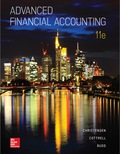
EBK ADVANCED FINANCIAL ACCOUNTING
11th Edition
ISBN: 8220102796096
Author: Christensen
Publisher: YUZU
expand_more
expand_more
format_list_bulleted
Concept explainers
Question
Chapter 2, Problem 2.25P
a.
To determine
Introduction:
The consolidated
To prepare: A
a.
Expert Solution
Explanation of Solution
| Particular | Dr. | Cr. |
| Equity method entry on paper’s co.’s books | ||
| Investment in scissor co. Dr. | ||
| Cash Cr. | ||
| Record initial investment in scissor co. | ||
| Investment in scissor co. Dr. | ||
| Income from scissor co. Cr. | ||
| Cash Dr. | ||
| Investment in S Cr. | ||
| Record paper co. share in scissor co. dividend | ||
| Total |
b.
To determine
Concept introduction
The consolidated balance sheet and the worksheets are the computed tools that are used to calculate the retained earnings and the dividend produced by the subsidiaries towards its parent company.
To prepare: the consolidated worksheet for the final values
b.
Expert Solution
Answer to Problem 2.25P
The consolidated worksheet is prepared and discussed.
Explanation of Solution
| Book value calculation | |||||
| Total book value | = | Common stock | + | Retained earnings | |
| Book value | |||||
| Net income | |||||
| Dividend | |||||
| Ending book value |
| Income statement | P | S | Dr. | Cr. | consolidated |
| Sales | |||||
| Less Cogs | |||||
| Depreciation Exp | |||||
| Sel. Exp | |||||
| Income | |||||
| Net income |
| Statement of Retain Earning | P | S | Dr. | Cr. | Consolidated |
| Opening balance | |||||
| Net income | |||||
| Less dividend declared | |||||
| End balance |
| Income statement | Paper co | Scissor co | Eliminated DR | Eliminated CR | consolidated |
| Cash | |||||
| Accounts received | |||||
| Inventory | |||||
| Investment in scissor co | |||||
| Land | |||||
| Building and equipment | |||||
| Less accumulated depreciation | |||||
| Total assets | |||||
| Account payable | |||||
| Bonds | |||||
| Common stocks | |||||
| Retained earnings | |||||
| Total liabilities |
Want to see more full solutions like this?
Subscribe now to access step-by-step solutions to millions of textbook problems written by subject matter experts!
Students have asked these similar questions
Calculate the amount of gross profit
Anjali Brewery has estimated budgeted costs of $72,600, $78,900, and $85,200 for the manufacture of 4,000, 5,000, and 6,000 gallons of beer, respectively, next quarter. What are the variable and fixed manufacturing costs in the flexible budget for Anjali Brewery?
Determine the depreciation
Chapter 2 Solutions
EBK ADVANCED FINANCIAL ACCOUNTING
Ch. 2 - What types of investments in common stock normally...Ch. 2 - Prob. 2.2AQCh. 2 - When is equity method reporting considered...Ch. 2 - Prob. 2.4QCh. 2 - Prob. 2.5QCh. 2 - Prob. 2.6QCh. 2 - Prob. 2.7QCh. 2 - Prob. 2.8QCh. 2 - How does carrying securities at fair value...Ch. 2 - How does the fully adjusted equity method differ...
Ch. 2 - Prob. 2.11QCh. 2 - What is the modified equity method? When might a...Ch. 2 - Prob. 2.13AQCh. 2 - Prob. 2.14QCh. 2 - Prob. 2.15QCh. 2 - Prob. 2.16QCh. 2 - Prob. 2.17QCh. 2 - How are a subsidiary’s dividend declarations...Ch. 2 - Prob. 2.19QCh. 2 - Give a definition of consolidated retained...Ch. 2 - Prob. 2.21QCh. 2 - Prob. 2.22QCh. 2 - Choice of Accounting Method Slanted Building...Ch. 2 - Prob. 2.2CCh. 2 - Prob. 2.3ACCh. 2 - Prob. 2.4CCh. 2 - Prob. 2.5CCh. 2 - Prob. 2.6CCh. 2 - Prob. 2.1.1ECh. 2 - Multiple-Choice Questions on Accounting for Equity...Ch. 2 - Prob. 2.1.3ECh. 2 - Prob. 2.1.4ECh. 2 - Prob. 2.1.5ECh. 2 - Prob. 2.1.6ECh. 2 - Multiple-Choice Questions on Intercorporate...Ch. 2 - Prob. 2.2.2ECh. 2 - Prob. 2.3.1ECh. 2 - Prob. 2.3.2ECh. 2 - Prob. 2.3.3ECh. 2 - Prob. 2.3.4ECh. 2 - Cost versus Equity Reporting Winston Corporation...Ch. 2 - Prob. 2.5ECh. 2 - Prob. 2.6ECh. 2 - Prob. 2.7ECh. 2 - Income Reporting Grandview Company purchased 40...Ch. 2 - Prob. 2.9ECh. 2 - Carrying an Investment at Fair Value versus Equity...Ch. 2 - Investee with Preferred Stock Outstanding Reden...Ch. 2 - Prob. 2.12AECh. 2 - Prob. 2.13AECh. 2 - Prob. 2.14ECh. 2 - Prob. 2.15ECh. 2 - Prob. 2.16ECh. 2 - Prob. 2.17ECh. 2 - Changes ¡n the Number of Shares Held Idle...Ch. 2 - Prob. 2.19PCh. 2 - Carried at Fair Value Journal Entries Marlow...Ch. 2 - Prob. 2.21APCh. 2 - Equity-Method Income Statement Wealthy...Ch. 2 - Consolidated Worksheet at End of the First Year of...Ch. 2 - Consolidated Worksheet at End of the Second Year...Ch. 2 - Prob. 2.25PCh. 2 - Prob. 2.26PCh. 2 - Prob. 2.27BPCh. 2 - Prob. 2.28BP
Knowledge Booster
Learn more about
Need a deep-dive on the concept behind this application? Look no further. Learn more about this topic, accounting and related others by exploring similar questions and additional content below.Similar questions
arrow_back_ios
SEE MORE QUESTIONS
arrow_forward_ios
Recommended textbooks for you
